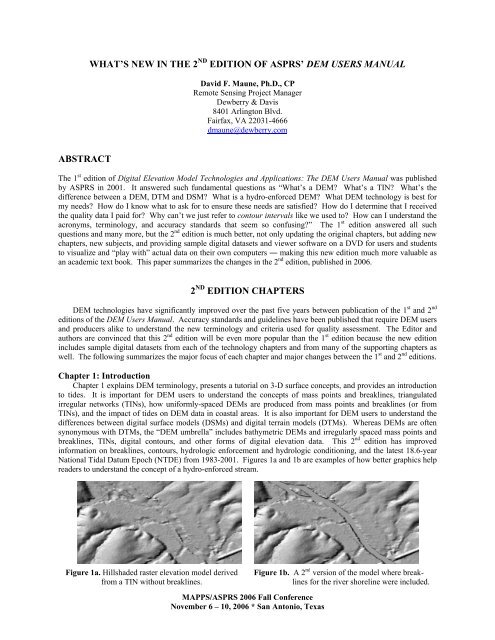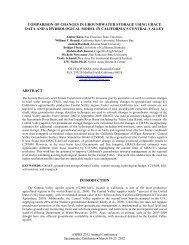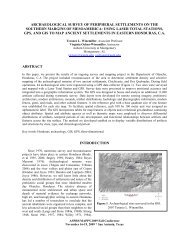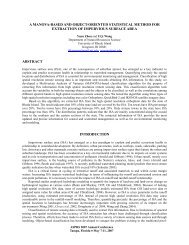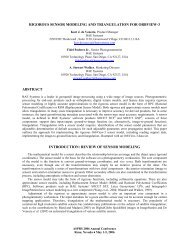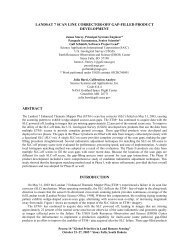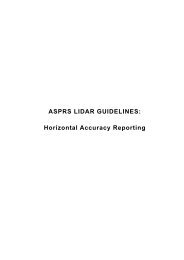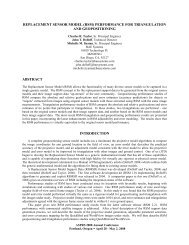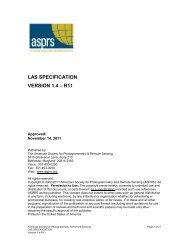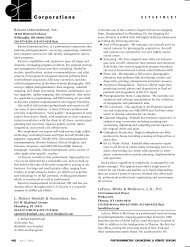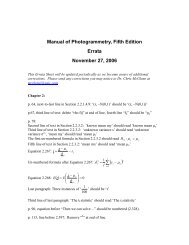dem users manual - asprs
dem users manual - asprs
dem users manual - asprs
You also want an ePaper? Increase the reach of your titles
YUMPU automatically turns print PDFs into web optimized ePapers that Google loves.
ABSTRACT<br />
WHAT’S NEW IN THE 2 ND EDITION OF ASPRS’ DEM USERS MANUAL<br />
David F. Maune, Ph.D., CP<br />
Remote Sensing Project Manager<br />
Dewberry & Davis<br />
8401 Arlington Blvd.<br />
Fairfax, VA 22031-4666<br />
dmaune@dewberry.com<br />
The 1 st edition of Digital Elevation Model Technologies and Applications: The DEM Users Manual was published<br />
by ASPRS in 2001. It answered such fundamental questions as “What’s a DEM? What’s a TIN? What’s the<br />
difference between a DEM, DTM and DSM? What is a hydro-enforced DEM? What DEM technology is best for<br />
my needs? How do I know what to ask for to ensure these needs are satisfied? How do I determine that I received<br />
the quality data I paid for? Why can’t we just refer to contour intervals like we used to? How can I understand the<br />
acronyms, terminology, and accuracy standards that seem so confusing?” The 1 st edition answered all such<br />
questions and many more, but the 2 nd edition is much better, not only updating the original chapters, but adding new<br />
chapters, new subjects, and providing sample digital datasets and viewer software on a DVD for <strong>users</strong> and students<br />
to visualize and “play with” actual data on their own computers ― making this new edition much more valuable as<br />
an aca<strong>dem</strong>ic text book. This paper summarizes the changes in the 2 nd edition, published in 2006.<br />
2 ND EDITION CHAPTERS<br />
DEM technologies have significantly improved over the past five years between publication of the 1 st and 2 nd<br />
editions of the DEM Users Manual. Accuracy standards and guidelines have been published that require DEM <strong>users</strong><br />
and producers alike to understand the new terminology and criteria used for quality assessment. The Editor and<br />
authors are convinced that this 2 nd edition will be even more popular than the 1 st edition because the new edition<br />
includes sample digital datasets from each of the technology chapters and from many of the supporting chapters as<br />
well. The following summarizes the major focus of each chapter and major changes between the 1 st and 2 nd editions.<br />
Chapter 1: Introduction<br />
Chapter 1 explains DEM terminology, presents a tutorial on 3-D surface concepts, and provides an introduction<br />
to tides. It is important for DEM <strong>users</strong> to understand the concepts of mass points and breaklines, triangulated<br />
irregular networks (TINs), how uniformly-spaced DEMs are produced from mass points and breaklines (or from<br />
TINs), and the impact of tides on DEM data in coastal areas. It is also important for DEM <strong>users</strong> to understand the<br />
differences between digital surface models (DSMs) and digital terrain models (DTMs). Whereas DEMs are often<br />
synonymous with DTMs, the “DEM umbrella” includes bathymetric DEMs and irregularly spaced mass points and<br />
breaklines, TINs, digital contours, and other forms of digital elevation data. This 2 nd edition has improved<br />
information on breaklines, contours, hydrologic enforcement and hydrologic conditioning, and the latest 18.6-year<br />
National Tidal Datum Epoch (NTDE) from 1983-2001. Figures 1a and 1b are examples of how better graphics help<br />
readers to understand the concept of a hydro-enforced stream.<br />
Figure 1a. Hillshaded raster elevation model derived<br />
from a TIN without breaklines.<br />
MAPPS/ASPRS 2006 Fall Conference<br />
November 6 – 10, 2006 * San Antonio, Texas<br />
Figure 1b. A 2 nd version of the model where break-<br />
lines for the river shoreline were included.
Chapter 2: Vertical Datums<br />
Chapter 2 explains why there are so many vertical datums used in the United States and why the “official”<br />
North American Vertical Datum of 1988 (NAVD 88) is normally the only one that ought to be used for topographic<br />
applications. It also explains the different tidal datums and how they are used. It is essential that DEM <strong>users</strong><br />
understand what the geoid is, the difference between ellipsoid heights and orthometric heights, and reasons why<br />
DEM <strong>users</strong> should not combine data sets that are referenced to different datums. This is the only chapter with<br />
relatively minor changes between the 1 st and 2 nd editions.<br />
Chapter 3: Accuracy Standards and Guidelines<br />
Chapter 3 explains the National Standard for Spatial Data Accuracy (NSSDA) and compares it with the<br />
traditional National Map Accuracy Standard (NMAS) published in 1947, as well as the ASPRS Standard for Large<br />
Scale Maps published in 1990 (ASPRS 90), both of which were replaced by the NSSDA. Chapter 3 also explains<br />
the relevant standards for hydrographic surveys and the new National Ocean Service “Hydrographic Surveys<br />
Specifications and Deliverables.” This 2 nd edition also includes the new Appendix A, Aerial Mapping and<br />
Surveying, to FEMA’s “Guidelines and Specifications for Flood Hazard Mapping Partners;” the National Digital<br />
Elevation Program (NDEP) “Guidelines for Digital Elevation Data;” and the “ASPRS Guidelines, Vertical Accuracy<br />
Reporting for Lidar Data,” the covers of which are shown in Figures 2a, 2b and 2c. If you don’t know the meanings<br />
of Fundamental Vertical Accuracy (FVA), Consolidated Vertical Accuracy (CVA) and Supplemental Vertical<br />
Accuracy (SVA), Chapter 3 explains what you need to know; and Chapter 12 (DEM Quality Assessment) provides<br />
actual examples of FVA, CVA and SVA statistics and reporting.<br />
Figure 2a. New FEMA Guidelines Figure 2b. New NDEP Guidelines Figure 2c. New ASPRS Guidelines<br />
Chapter 4: National Elevation Dataset<br />
Chapter 4 explains the National Elevation Dataset (NED) which includes the best available standard DEMs<br />
produced and/or distributed nationwide by USGS, comprising the elevation layer of The National Map. NED data<br />
are available to the public at minimal cost, and all <strong>users</strong> are encouraged to share their data sets with the NED which<br />
places DEM data in the public domain. This 2 nd edition does a better job explaining the three NED resolution layers<br />
available, and how such data can be obtained by the public. Samples of NED data are provided on the DVD<br />
included with this 2 nd edition. Figure 3 helps explain procedures for obtaining NED data.<br />
Chapter 5: Photogrammetry<br />
Chapter 5 has been rewritten to incorporate the latest information from the 5 th Edition of the Manual of<br />
Photogrammetry published by ASPRS. In addition to film cameras, it addresses the latest airborne digital systems<br />
and satellite imagery. For production of digital elevation data, it addresses planning considerations, georeferencing<br />
and aerotriangulation, photogrammetric data collection methods, post processing, quality control, data deliverables,<br />
supporting technologies, calibration procedures, capabilities and limitations compared with competing and/or<br />
complementary technologies, user applications, cost considerations, and technological advancements for the future.<br />
MAPPS/ASPRS 2006 Fall Conference<br />
November 6 – 10, 2006 * San Antonio, Texas
Figure 3. Web-based seamless data distribution system (http://seamless.usgs.gov/) for viewing and downloading of<br />
NED products (left). Large area coverage of NED products available on hard media (right).<br />
Samples of photogrammetric mass points, breaklines and contours are provided on the DVD included with the<br />
<strong>manual</strong>. Figure 4 provides examples of images that help readers understand a major advantage of softcopy<br />
workstations, i.e., their ability to superimpose all elevation points, and even contours, for review against the actual<br />
ground form, and the ability to selectively review existing, new, and changed data in the same stereoscopic display.<br />
Figure 4. Review of automated terrain extraction by superimposing color-coded crosses to show post accuracies.<br />
MAPPS/ASPRS 2006 Fall Conference<br />
November 6 – 10, 2006 * San Antonio, Texas
Chapter 6: IFSAR<br />
Chapter 6 explains the capabilities and limitations of Interferometric Synthetic Aperture Radar (IFSAR), both<br />
airborne and spaceborne. This technology sees through clouds, is less weather dependent that other technologies,<br />
and acquires elevation data sets of large areas at relatively low costs. It is important that DEM <strong>users</strong> understand that<br />
elevations derived from x-band IFSAR are initially the elevations of top surfaces (treetops and rooftops) and not the<br />
bare-earth terrain, so if you need DSMs of large areas, this technology may be best for you. DTMs can be produced<br />
from IFSAR DSMs, and a sample IFSAR data set, including an orthorectified radar image, is included on the DVD<br />
that accompanies this 2 nd edition. Figure 5 helps explain how Synthetic Aperture Radar (SAR) works.<br />
Figure 5. The 3-D world is collapsed to 2-D in conventional SAR imaging. After image formation, the radar return<br />
is resolved into an image in range-azimuth coordinates. This figure shows a profile of the terrain at constant<br />
azimuth, with the radar flight track into the page.<br />
Chapter 7: Topographic and Terrestrial Lidar<br />
Chapter 7 is improved significantly from the 1 st edition, especially in describing different laser systems and how<br />
they work, modern sensors with very high pulse repetition rates, and explaining what a lidar point cloud is. This 2 nd<br />
edition includes entirely new sections on lidargrammetry and ground-based lidar (terrestrial laser scanning) for<br />
which there are nearly 2000 systems in use worldwide today, providing high resolution scanned images of<br />
infrastructure so detailed that every pixel has its own 3-D coordinate. Many different sample lidar datasets are<br />
provided on the DVD included with this 2 nd edition, including topographic and terrestrial lidar and fly-throughs.<br />
Figure 6a shows a point cloud from an airborne lidar sensor, color-coding different lidar returns from the trees and<br />
ground. Figure 6b shows a terrestrial lidar dataset (terrestrial laser scan) what looks like a photograph, except that<br />
every pixel has 3-D coordinates so that as-built measurements are quickly and accurately surveyed.<br />
Figure 6a. Topographic lidar “point clouds,” colorcoded<br />
for 1 st through 4 th returns. Many 1 st returns<br />
(yellow) reach the ground, whereas some of the 3 rd<br />
returns (red) are still in the trees and don’t penetrate.<br />
Figure 6b. High-resolution laser image of a fluid catalytic<br />
cracker (FCC) in a refinery captured with a phased-based<br />
scanner. Each pixel has 3-D x/y/z coordinates.<br />
MAPPS/ASPRS 2006 Fall Conference<br />
November 6 – 10, 2006 * San Antonio, Texas
Chapter 8: Airborne Lidar Bathymetry<br />
Chapter 8 documents in detail how this rapidly emerging airborne<br />
lidar bathymetry (ALB) technology is complementary to both sonar and<br />
topographic lidar. ALB systems are able to survey the terrain above and<br />
below the water surface down to a depth limited by the clarity of the water.<br />
ALB is ideal for operations in clear water to depths of 50 meters and near<br />
the land/shore interface for a wide range of near-shore surveying and<br />
engineering applications where sonar may be limited and/or inefficient.<br />
The 2 nd edition includes a considerable number of updates from the 1 st<br />
edition. The enclosed DVD includes a sample ALB dataset. Figure 7 helps<br />
explain how ALB technology works.<br />
Chapter 9: Sonar<br />
Chapter 9 explains the basic principles of sonar systems and<br />
compares the various kinds of sonars in use today, including vertical<br />
beam, multibeam, interferometric, and side-scan sonar. It compares<br />
these technologies with competing and complementary technologies.<br />
Figure 8. Digital Terrain Model on chart of Eastern Long<br />
Island Sound in 2003, by NOAA Ship Thomas Jefferson.<br />
MAPPS/ASPRS 2006 Fall Conference<br />
November 6 – 10, 2006 * San Antonio, Texas<br />
Figure 7. Schematic diagram of the<br />
effects of scattering on the ALB’s green<br />
lidar beam.<br />
The 2 nd edition has much better graphics than the 1 st<br />
edition of this <strong>manual</strong>, helping the topographic maping<br />
community to better understand the bathymetric<br />
and hydrographic surveying community, including<br />
similarities and differences. The DVD accompanying<br />
this 2 nd edition includes interesting examples of multibeam<br />
and side-scan sonar and ancillary data.<br />
Figure 8 shows a sample DTM of Eastern Long<br />
Island Sound. It is interesting to note that the<br />
procedures used for QA/QC of bathymetric data are<br />
very similar to procedures used for QA/QC of<br />
topographic data.<br />
Chapter 9 does an excellent job of showing the<br />
similarities and differences in mapping the terrain both<br />
above and below the water’s surface.<br />
Chapter 10: Enabling Technologies<br />
Chapter 10 supports all the technologies described in Chapters 5 through 9 and answers the question of how<br />
such high geopositioning accuracies are achievable. This chapter includes updated sections on precise Global<br />
Positioning System (GPS) positioning on rapidly-moving platforms; GPS-aided inertial navigation systems; direct<br />
georeferencing systems for airborne remote sensing; and motion sensing systems for multibeam sonar bathymetry.<br />
Chapter 11: DEM User Applications<br />
Chapter 11 provides detailed explanations, plus numerous graphic examples, of how digital elevation data are<br />
used in innovative ways for diverse mapping applications; transportation applications (land, air and sea); underwater<br />
and other technical applications; military, commercial and individual applications. The 2 nd edition includes a new<br />
section on coastal mapping applications (shoreline delineation, sea level rise, coastal management, coastal<br />
engineering, and coastal inundation) and a new section on geological applications of digital elevation data. The<br />
DVD accompanying this 2 nd edition includes an interesting 3-D fly-through of a virtual city (Detroit, MI).<br />
Chapter 12: DEM Quality Assessment<br />
Chapter 12 has been largely re-written to address new accuracy standards and guidelines published by FEMA,<br />
NDEP and ASPRS since the 1 st edition. This chapter addresses Quality Assurance/Quality Control (QA/QC) goals<br />
and definitions; quantitative procedures (with example statistics and graphics for a lidar dataset) for assessing digital<br />
elevation data accuracy in accordance with FEMA, NDEP and ASPRS guidelines and accuracy reporting consistent<br />
with NSSDA requirements; different procedures used for qualitative assessments of digital topographic data at<br />
macro and micro levels (with issues and examples); and procedures used by NOAA for quality assessment of digital
hydrographic data. Tables 1 through 4 provide sample dataset calculations of FVA, CVA, SVA and other accuracy<br />
reporting statistics from the quantitative assessment of a lidar dataset.<br />
Table 1 ― DTM Acceptance Criteria from Sample Project Quality Plan<br />
Table 2 ― FVA, CVA and SVA at 95% Confidence Level<br />
Table 3 ― 5% CVA Outliers Larger than 95 th Percentile<br />
Table 4 ― Descriptive Statistics by Land Cover Category<br />
Figure 9 shows errors detected from Dewberry’s independent QA/QC assessments of elevation datasets. Figure<br />
9a illustrates a scan line with high elevations, merged with adjacent scan lines which had the correct elevations; this<br />
tile also was initially classified as bare-earth terrain but it is clear that vegetation still exists within this tile. Figure<br />
9b illustrates a processing error by the vendor where an antenna offset was not applied when reducing the data.<br />
Figures 9c, 9d and 9e show the results of over-smoothing. Figure 9c shows correct processing in the north<br />
(Area A), over-smoothing in the south (Area B). Figure 9d uses cross sections that show a stream in the north and a<br />
pseudo-levee in the south. Figure 9e is an orthophoto that shows the DTM should depict a stream throughout.<br />
MAPPS/ASPRS 2006 Fall Conference<br />
November 6 – 10, 2006 * San Antonio, Texas
Figure 9a. Uncleaned<br />
artifacts (vegetation)<br />
and scan line error.<br />
Figure 9b. Wrong<br />
antenna offset was<br />
used for one tile.<br />
Figure 9c. Area A is<br />
noisy but correct.<br />
Area B is oversmoothed.<br />
Figure 9d. Cross<br />
sections show the<br />
stream becomes a<br />
pseudo-levee.<br />
MAPPS/ASPRS 2006 Fall Conference<br />
November 6 – 10, 2006 * San Antonio, Texas<br />
Figure 9e. Orthophoto<br />
shows reality;<br />
DTM should depict<br />
stream throughout.<br />
Chapter 13: DEM User Requirements<br />
Chapter 13 updates the popular User Requirements Menu with explanations of menu choices, further explains<br />
the new accuracy standards (FVA, CVA and SVA), and provides example Statements of Work (SOWs) for <strong>users</strong><br />
who need help in documenting requirements for digital elevation data that also satisfy requirements of Appendix A,<br />
Guidance for Aerial Mapping and Surveying, to FEMA’s “Guidelines and Specifications for Flood Hazard Mapping<br />
Partners.” By popular <strong>dem</strong>and, the User Requirements Menu and two example SOWs are included digitally (as<br />
Word documents) on the DVD accompanying this 2 nd edition.<br />
Chapter 14: Lidar Processing and Software<br />
Chapter 14 is new for the 2 nd edition. It explains lidar software requirements and process flow, to include data<br />
collection, raw data calibration and QA, data production of classified data, and high-level analysis of discrete<br />
features, including automated feature extraction. This chapter peers into the future with regard to lidar software and<br />
processing. Chapter 14 shows many pairs of before/after images to <strong>dem</strong>onstrate the results of various lidar data<br />
processing steps. Figure 10 is one such example where Figure 10a shows what contours would look like before a<br />
double-line stream is hydro-enforced, and Figure 10b shows the contours after hydro-enforcement through the use of<br />
3-D breaklines (polylines).<br />
Figure 10a. Pre-hydro-enforced ground model.<br />
Figure 10b. Hydro-enforced model.<br />
Chapter 15: Sample Elevation Datasets<br />
Chapter 15 is also totally new, and it is the most exciting addition to the 2 nd edition. It explains the viewer<br />
software and sample datasets on the DVD included with the <strong>manual</strong>. Readers with a computer and DVD reader<br />
should explore the contents of the DVD and view the impressive array of sample data, including: NED data (Chapter<br />
4), photogrammetric data (Chapter 5), IFSAR data (Chapter 6), topographic lidar data (Chapter 7), terrestrial laser
scan data (Chapter 7), bathymetric lidar data (Chapter 8), and sonar data (Chapter 9). It also includes avi video flythroughs<br />
of elevation data from multiple sources, including Pictometry imagery, topographic and terrestrial lidar.<br />
The software and various datasets on the DVD are all explained in this exciting new chapter.<br />
Appendices<br />
Appendix A compiles over 350 acronyms used in the <strong>manual</strong>, and Appendix B provides nearly 400 definitions.<br />
Thus, if a reader encounters an unfamiliar term and may not recall where that term was defined, look in Appendix B<br />
where hundreds of terms are listed alphabetically, and defined. Appendix C is the color appendix, where all color<br />
Figures are printed.<br />
SUMMARY<br />
It has long been the Editor’s goal that the 2 nd edition not only update the technical content of each chapter, but<br />
also provide a DVD for <strong>users</strong> to gain some hands-on experience in “playing with” sample elevation datasets. This<br />
DVD will hopefully be instrumental to the development of an exciting aca<strong>dem</strong>ic curriculum in which DEM<br />
technologies and applications are taught to our future industry practitioners. Professors and students will not be<br />
disappointed.<br />
As with the 1 st edition, the new edition has been a voluntary labor of love by the various chapter authors, all of<br />
whom are experts in their particular fields. Their efforts are truly appreciated<br />
The 2 nd edition is dedicated to the memories of two special people who authored chapters in the 1 st and/or 2 nd<br />
editions of the DEM Users Manual and who passed away prior to publication of the 2 nd edition. Ken Osborn was<br />
the principal author of Chapter 4 (National Digital Elevation Program) in the 1 st edition; Ken passed away in March<br />
of 2004. Bob Fowler was the principal author of Chapter 7 (Topographic Lidar) in the 1 st edition, and Chapter 7<br />
(Topographic and Terrestrial Lidar) in the 2 nd edition; Bob passed away in July of 2006. Bob’s last email to the<br />
Editor was when he concurred with the final manuscript of Chapter 7. Ken and Bob both dedicated their careers to<br />
promote greater understanding of DEM technologies and applications and greater access to digital elevation data.<br />
Both were true professionals and friends of the imaging and geospatial information communities that comprise the<br />
“ASPRS family.”<br />
MAPPS/ASPRS 2006 Fall Conference<br />
November 6 – 10, 2006 * San Antonio, Texas


